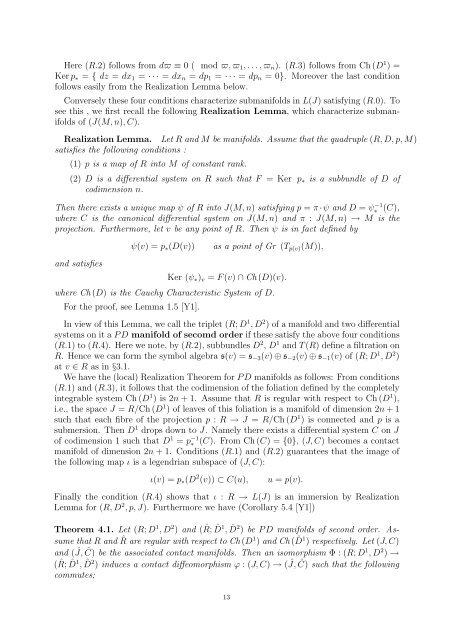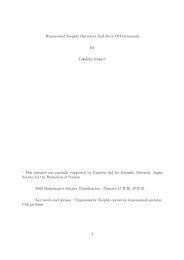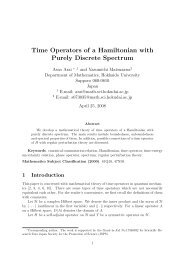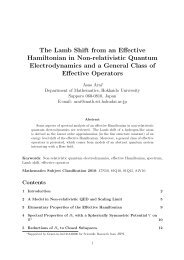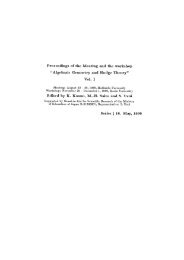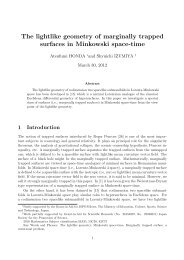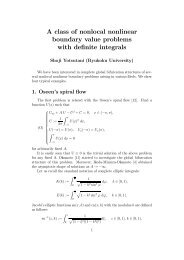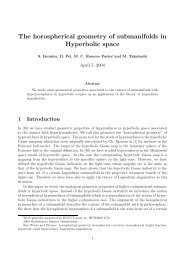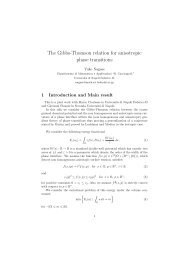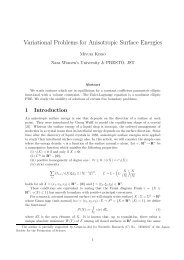Contact Geometry of second order I - Dept. Math, Hokkaido Univ ...
Contact Geometry of second order I - Dept. Math, Hokkaido Univ ...
Contact Geometry of second order I - Dept. Math, Hokkaido Univ ...
Create successful ePaper yourself
Turn your PDF publications into a flip-book with our unique Google optimized e-Paper software.
Here (R.2) follows from dϖ ≡ 0 ( mod ϖ, ϖ1, . . . , ϖn). (R.3) follows from Ch (D 1 ) =<br />
Ker p∗ = { dz = dx1 = · · · = dxn = dp1 = · · · = dpn = 0}. Moreover the last condition<br />
follows easily from the Realization Lemma below.<br />
Conversely these four conditions characterize submanifolds in L(J) satisfying (R.0). To<br />
see this , we first recall the following Realization Lemma, which characterize submanifolds<br />
<strong>of</strong> (J(M, n), C).<br />
Realization Lemma. Let R and M be manifolds. Assume that the quadruple (R, D, p, M)<br />
satisfies the following conditions :<br />
(1) p is a map <strong>of</strong> R into M <strong>of</strong> constant rank.<br />
(2) D is a differential system on R such that F = Ker p∗ is a subbundle <strong>of</strong> D <strong>of</strong><br />
codimension n.<br />
Then there exists a unique map ψ <strong>of</strong> R into J(M, n) satisfying p = π ·ψ and D = ψ −1<br />
∗ (C),<br />
where C is the canonical differential system on J(M, n) and π : J(M, n) → M is the<br />
projection. Furthermore, let v be any point <strong>of</strong> R. Then ψ is in fact defined by<br />
and satisfies<br />
ψ(v) = p∗(D(v)) as a point <strong>of</strong> Gr (Tp(v)(M)),<br />
Ker (ψ∗)v = F (v) ∩ Ch (D)(v).<br />
where Ch (D) is the Cauchy Characteristic System <strong>of</strong> D.<br />
For the pro<strong>of</strong>, see Lemma 1.5 [Y1].<br />
In view <strong>of</strong> this Lemma, we call the triplet (R; D 1 , D 2 ) <strong>of</strong> a manifold and two differential<br />
systems on it a P D manifold <strong>of</strong> secomd <strong>order</strong> if these satisfy the above four conditions<br />
(R.1) to (R.4). Here we note, by (R.2), subbundles D 2 , D 1 and T (R) define a filtration on<br />
R. Hence we can form the symbol algebra s(v) = s−3(v) ⊕ s−2(v) ⊕ s−1(v) <strong>of</strong> (R; D 1 , D 2 )<br />
at v ∈ R as in §3.1.<br />
We have the (local) Realization Theorem for P D manifolds as follows: From conditions<br />
(R.1) and (R.3), it follows that the codimension <strong>of</strong> the foliation defined by the completely<br />
integrable system Ch (D 1 ) is 2n + 1. Assume that R is regular with respect to Ch (D 1 ),<br />
i.e., the space J = R/Ch (D 1 ) <strong>of</strong> leaves <strong>of</strong> this foliation is a manifold <strong>of</strong> dimension 2n + 1<br />
such that each fibre <strong>of</strong> the projection p : R → J = R/Ch (D 1 ) is connected and p is a<br />
submersion. Then D 1 drops down to J. Namely there exists a differential system C on J<br />
<strong>of</strong> codimension 1 such that D 1 = p −1<br />
∗ (C). From Ch (C) = {0}, (J, C) becomes a contact<br />
manifold <strong>of</strong> dimension 2n + 1. Conditions (R.1) and (R.2) guarantees that the image <strong>of</strong><br />
the following map ι is a legendrian subspace <strong>of</strong> (J, C):<br />
ι(v) = p∗(D 2 (v)) ⊂ C(u), u = p(v).<br />
Finally the condition (R.4) shows that ι : R → L(J) is an immersion by Realization<br />
Lemma for (R, D 2 , p, J). Furthermore we have (Corollary 5.4 [Y1])<br />
Theorem 4.1. Let (R; D1 , D2 ) and ( ˆ R; ˆ D1 , ˆ D2 ) be P D manifolds <strong>of</strong> <strong>second</strong> <strong>order</strong>. Assume<br />
that R and ˆ R are regular with respect to Ch (D1 ) and Ch ( ˆ D1 ) respectively. Let (J, C)<br />
and ( ˆ J, Ĉ) be the associated contact manifolds. Then an isomorphism Φ : (R; D1 , D2 ) →<br />
( ˆ R; ˆ D1 , ˆ D2 ) induces a contact diffeomorphism ϕ : (J, C) → ( ˆ J, Ĉ) such that the following<br />
commutes;<br />
13


